2007 ISUZU KB P190 light
[x] Cancel search: lightPage 3921 of 6020
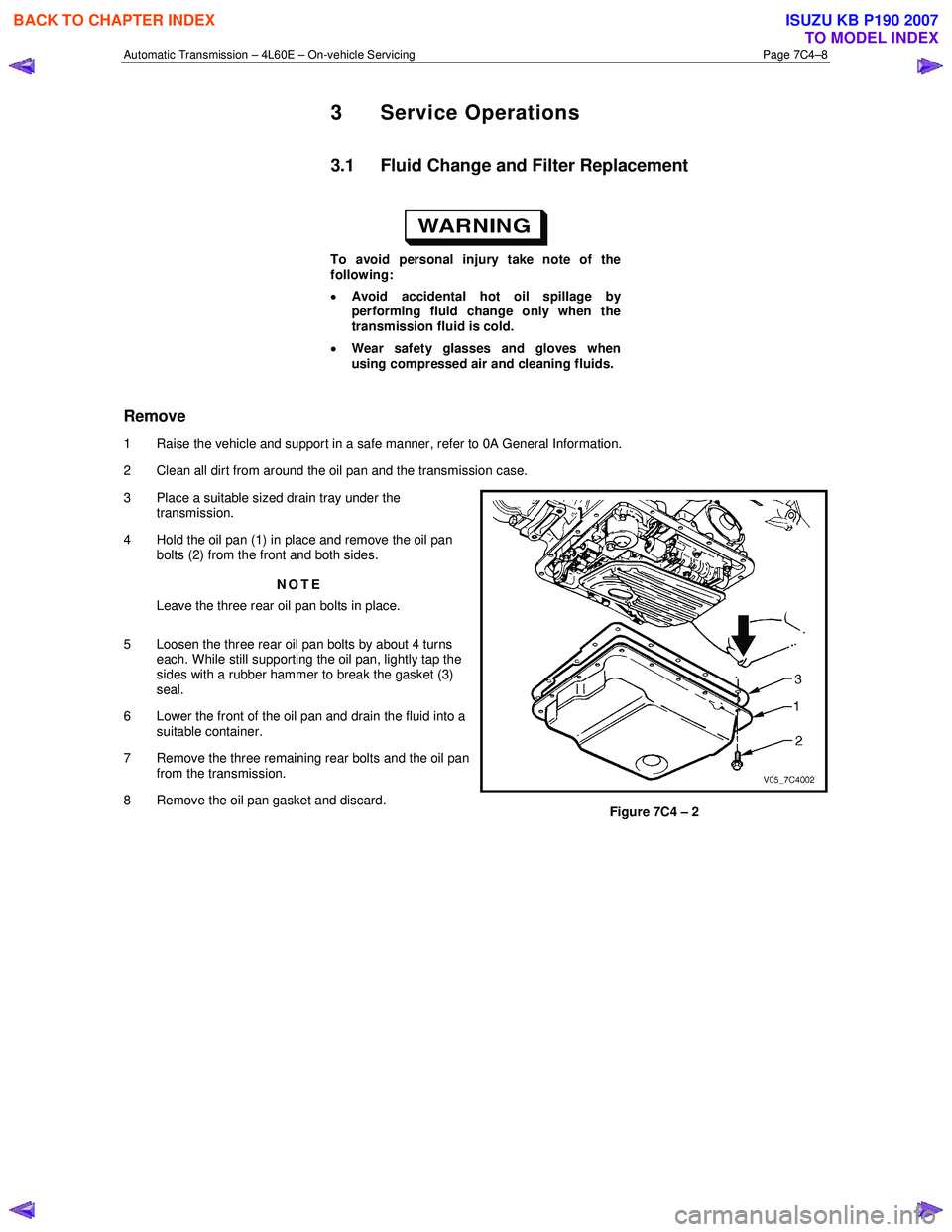
Automatic Transmission – 4L60E – On-vehicle Servicing Page 7C4–8
3 Service Operations
3.1 Fluid Change and Filter Replacement
To avoid personal injury take note of the
following:
• Avoid accidental hot oil spillage by
performing fluid change only when the
transmission fluid is cold.
• Wear safety glasses and gloves when
using compressed air and cleaning fluids.
Remove
1 Raise the vehicle and support in a safe manner, refer to 0A General Information.
2 Clean all dirt from around the oil pan and the transmission case.
3 Place a suitable sized drain tray under the transmission.
4 Hold the oil pan (1) in place and remove the oil pan bolts (2) from the front and both sides.
NOTE
Leave the three rear oil pan bolts in place.
5 Loosen the three rear oil pan bolts by about 4 turns each. While still supporting the oil pan, lightly tap the
sides with a rubber hammer to break the gasket (3)
seal.
6 Lower the front of the oil pan and drain the fluid into a suitable container.
7 Remove the three remaining rear bolts and the oil pan from the transmission.
8 Remove the oil pan gasket and discard.
Figure 7C4 – 2
BACK TO CHAPTER INDEX
TO MODEL INDEX
ISUZU KB P190 2007
Page 3930 of 6020

Automatic Transmission – 4L60E – On-vehicle Servicing Page 7C4–17
3 Remove the three attaching screws (1 and 2) and the
heat shield (3).
4 Hold the transmission manual shaft linkage (4) with an adjustable wrench and remove the linkage attaching
nut (5).
5 Carefully remove the manual shaft linkage and selector cable from the transmission manual shaft (6).
6 Prise the connector position assurance (CPA) securing pin (7) from the neutral start and back-up
lamp switch (8) taking care not to break the pin in the
process. Disconnect the connector (9) from the switch
assembly by pulling down the release bar (10).
NOTE
The connector will automatically disconnect at
the same time the release bar is withdrawn.
7 Remove the attaching screw (11) and slide the switch assembly over the transmission manual shaft to
remove it.
Figure 7C4 – 14
Reinstall
1 Slide the neutral start and back-up lamp switch (8) over the transmission manual shaft (6) and reinstall the two
attaching screws (1 and 11), tighten them finger tight until the adjustment process has been completed, refer to
Figure 7C4 – 14.
2 Install the manual shaft linkage (4) and the attaching nut (5). Hold the linkage with an adjustable wrench and tighten the nut to the correct torque specification.
Manual shaft linkage attaching nut
torque specification ............................................ 25.0 Nm
3 Install the connector (9) but do not reinsert the CPA securing pin (7) at this stage.
4 Check the shift selector linkage operation and adjust as required, refer to 3.2 Shift Selector Assembly.
5 Check and adjust as required the neutral start and back-up lamp switch as described in this Section, refer to Adjust.
Adjust
1 Raise the vehicle and support in a safe manner, refer to 0A General Information for the location of support points.
2 If required, loosen the neutral start and back-up lamp switch (8) as follows, refer to Figure 7C4 – 14: a Remove the three attaching screws (1 and 2) and the heat shield (3).
b Prise the connector position assurance (CPA) securing pin (7) from the neutral start and back-up lamp switch taking care not to break the pin in the process.
c Disconnect connector (9) from the switch assembly by pulling down the release bar (10).
NOTE
The connector will automatically disconnect at the
same time the release bar is withdrawn.
d Loosen the screw (11) attaching the switch and refit the front screw (1) keep them finger tight.
e Reinstall the connector (9) but do not reinsert the CPA securing pin at this stage.
3 Rotate the neutral start and back-up lamp switch back and forth until a central position is attained and then lightly tighten the front screw (1) to prevent the switch from rotating.
BACK TO CHAPTER INDEX
TO MODEL INDEX
ISUZU KB P190 2007
Page 3944 of 6020
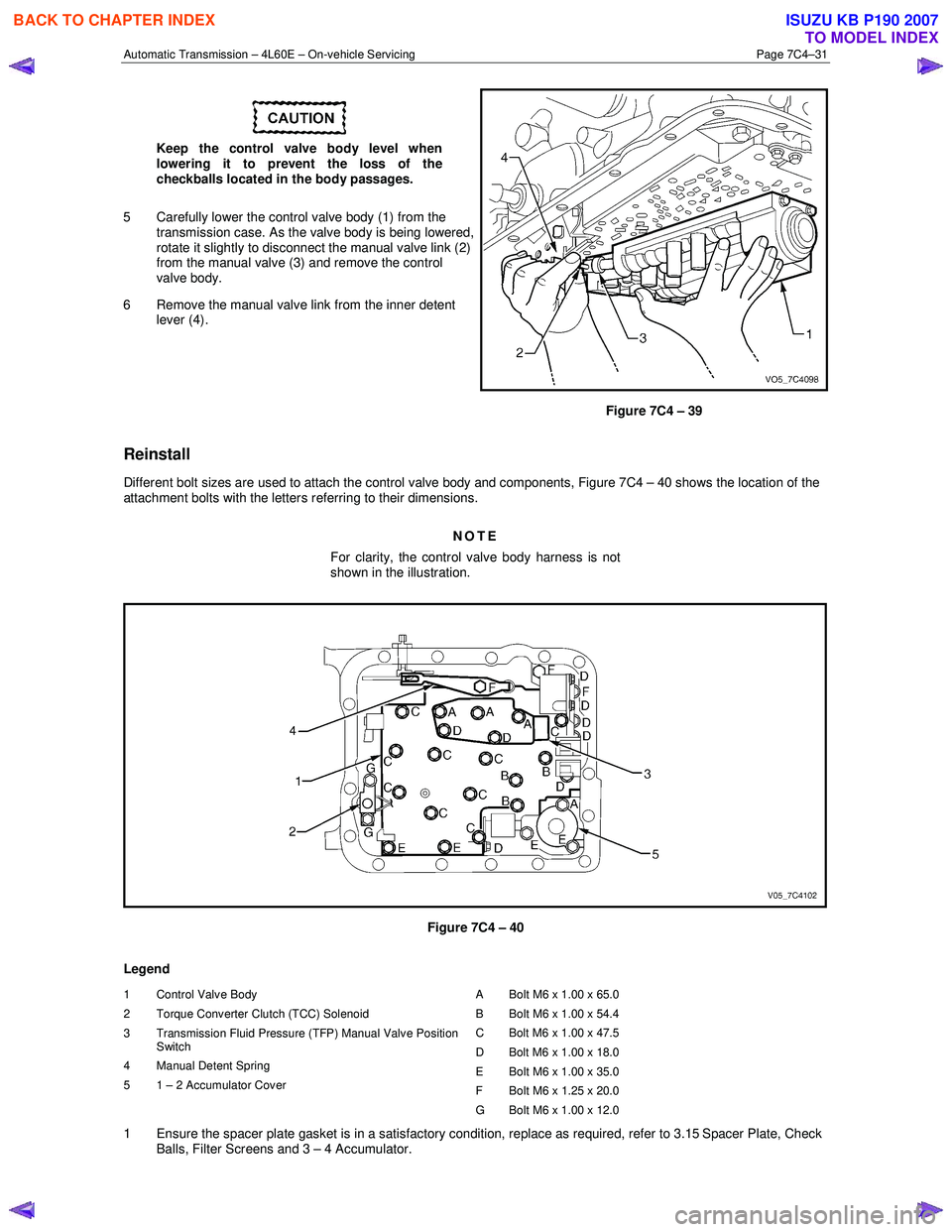
Automatic Transmission – 4L60E – On-vehicle Servicing Page 7C4–31
Keep the control valve body level when
lowering it to prevent the loss of the
checkballs located in the body passages.
5 Carefully lower the control valve body (1) from the transmission case. As the valve body is being lowered,
rotate it slightly to disconnect the manual valve link (2)
from the manual valve (3) and remove the control
valve body.
6 Remove the manual valve link from the inner detent lever (4).
Figure 7C4 – 39
Reinstall
Different bolt sizes are used to attach the control valve body and components, Figure 7C4 – 40 shows the location of the
attachment bolts with the letters referring to their dimensions.
NOTE
For clarity, the control valve body harness is not
shown in the illustration.
Figure 7C4 – 40
Legend
1 Control Valve Body
2 Torque Converter Clutch (TCC) Solenoid
3 Transmission Fluid Pressure (TFP) Manual Valve Position Switch
4 Manual Detent Spring
5 1 – 2 Accumulator Cover A Bolt M6 x 1.00 x 65.0
B Bolt M6 x 1.00 x 54.4
C Bolt M6 x 1.00 x 47.5
D Bolt M6 x 1.00 x 18.0
E Bolt M6 x 1.00 x 35.0
F Bolt M6 x 1.25 x 20.0
G Bolt M6 x 1.00 x 12.0
1 Ensure the spacer plate gasket is in a satisfactory condition, replace as required, refer to 3.15 Spacer Plate, Check Balls, Filter Screens and 3 – 4 Accumulator.
BACK TO CHAPTER INDEX
TO MODEL INDEX
ISUZU KB P190 2007
Page 3945 of 6020
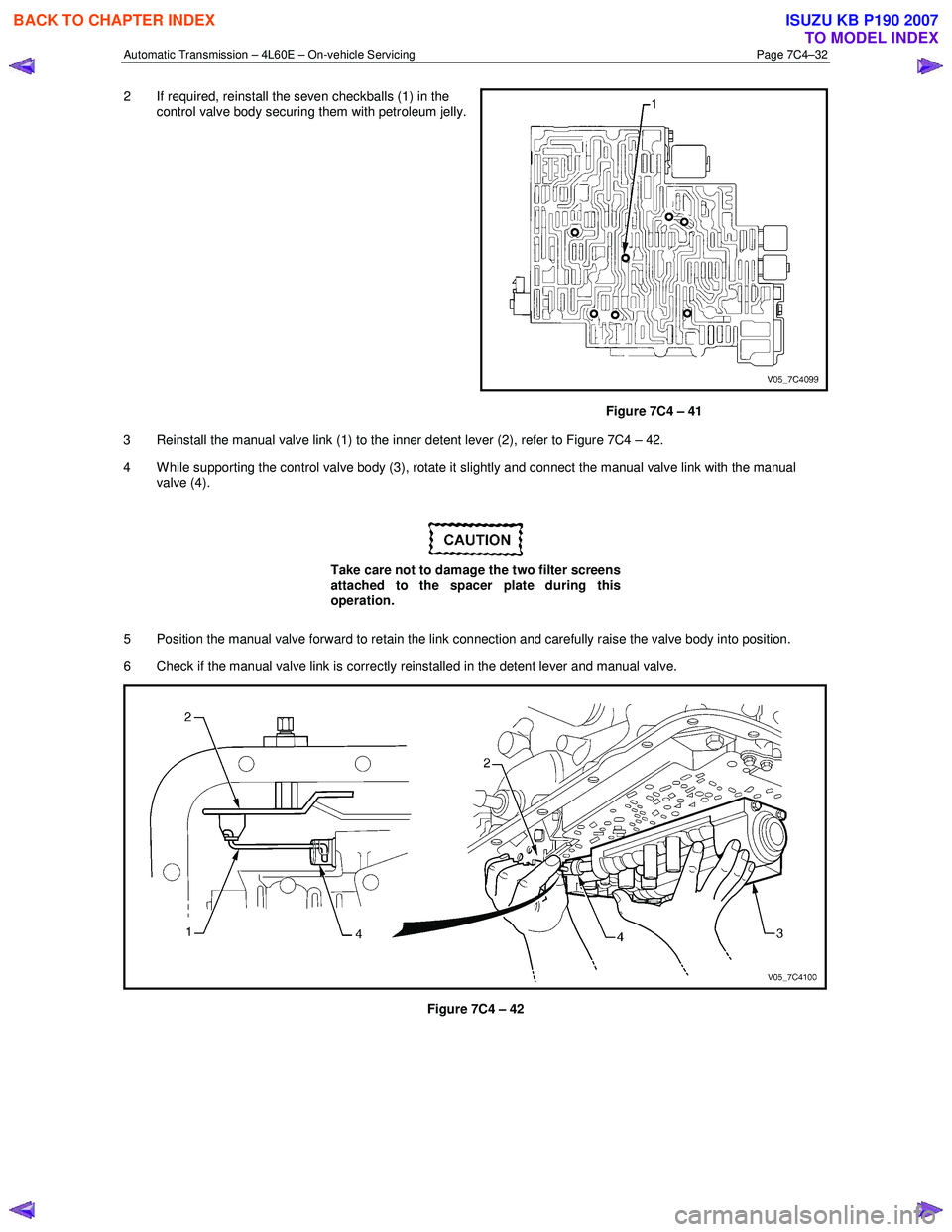
Automatic Transmission – 4L60E – On-vehicle Servicing Page 7C4–32
2 If required, reinstall the seven checkballs (1) in the
control valve body securing them with petroleum jelly.
Figure 7C4 – 41
3 Reinstall the manual valve link (1) to the inner detent lever (2), refer to Figure 7C4 – 42.
4 W hile supporting the control valve body (3), rotate it slightly and connect the manual valve link with the manual valve (4).
Take care not to damage the two filter screens
attached to the spacer plate during this
operation.
5 Position the manual valve forward to retain the link connection and carefully raise the valve body into position.
6 Check if the manual valve link is correctly reinstalled in the detent lever and manual valve.
Figure 7C4 – 42
BACK TO CHAPTER INDEX
TO MODEL INDEX
ISUZU KB P190 2007
Page 3956 of 6020
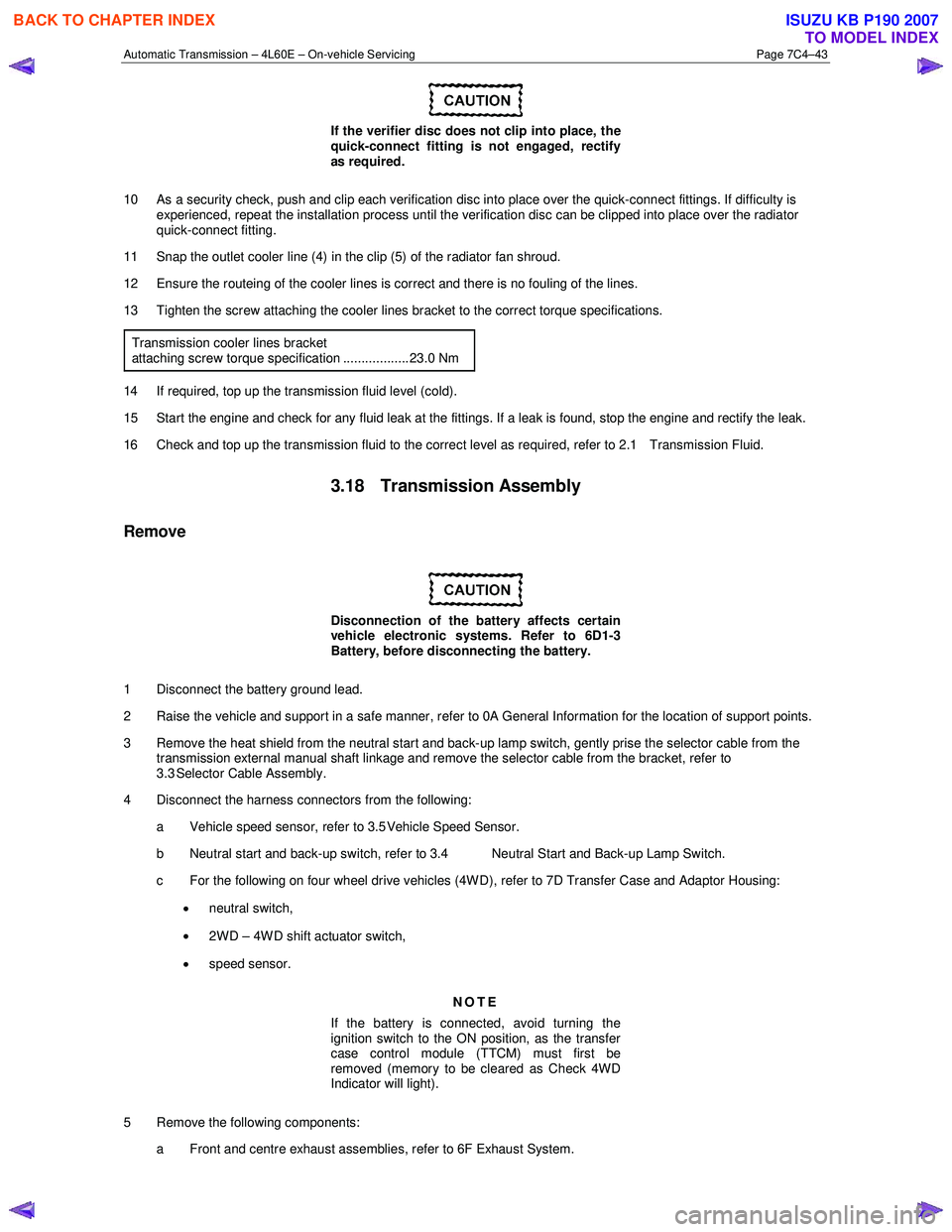
Automatic Transmission – 4L60E – On-vehicle Servicing Page 7C4–43
If the verifier disc does not clip into place, the
quick-connect fitting is not engaged, rectify
as required.
10 As a security check, push and clip each verification disc into place over the quick-connect fittings. If difficulty is experienced, repeat the installation process until the verification disc can be clipped into place over the radiator
quick-connect fitting.
11 Snap the outlet cooler line (4) in the clip (5) of the radiator fan shroud.
12 Ensure the routeing of the cooler lines is correct and there is no fouling of the lines.
13 Tighten the screw attaching the cooler lines bracket to the correct torque specifications.
Transmission cooler lines bracket
attaching screw torque specification .................. 23.0 Nm
14 If required, top up the transmission fluid level (cold).
15 Start the engine and check for any fluid leak at the fittings. If a leak is found, stop the engine and rectify the leak.
16 Check and top up the transmission fluid to the correct level as required, refer to 2.1 Transmission Fluid.
3.18 Transmission Assembly
Remove
Disconnection of the battery affects certain
vehicle electronic systems. Refer to 6D1-3
Battery, before disconnecting the battery.
1 Disconnect the battery ground lead.
2 Raise the vehicle and support in a safe manner, refer to 0A General Information for the location of support points.
3 Remove the heat shield from the neutral start and back-up lamp switch, gently prise the selector cable from the transmission external manual shaft linkage and remove the selector cable from the bracket, refer to
3.3 Selector Cable Assembly.
4 Disconnect the harness connectors from the following:
a Vehicle speed sensor, refer to 3.5 Vehicle Speed Sensor.
b Neutral start and back-up switch, refer to 3.4 Neutral Start and Back-up Lamp Switch.
c For the following on four wheel drive vehicles (4W D), refer to 7D Transfer Case and Adaptor Housing:
• neutral switch,
• 2WD – 4WD shift actuator switch,
• speed sensor.
NOTE
If the battery is connected, avoid turning the
ignition switch to the ON position, as the transfer
case control module (TTCM) must first be
removed (memory to be cleared as Check 4W D
Indicator will light).
5 Remove the following components: a Front and centre exhaust assemblies, refer to 6F Exhaust System.
BACK TO CHAPTER INDEX
TO MODEL INDEX
ISUZU KB P190 2007
Page 3979 of 6020
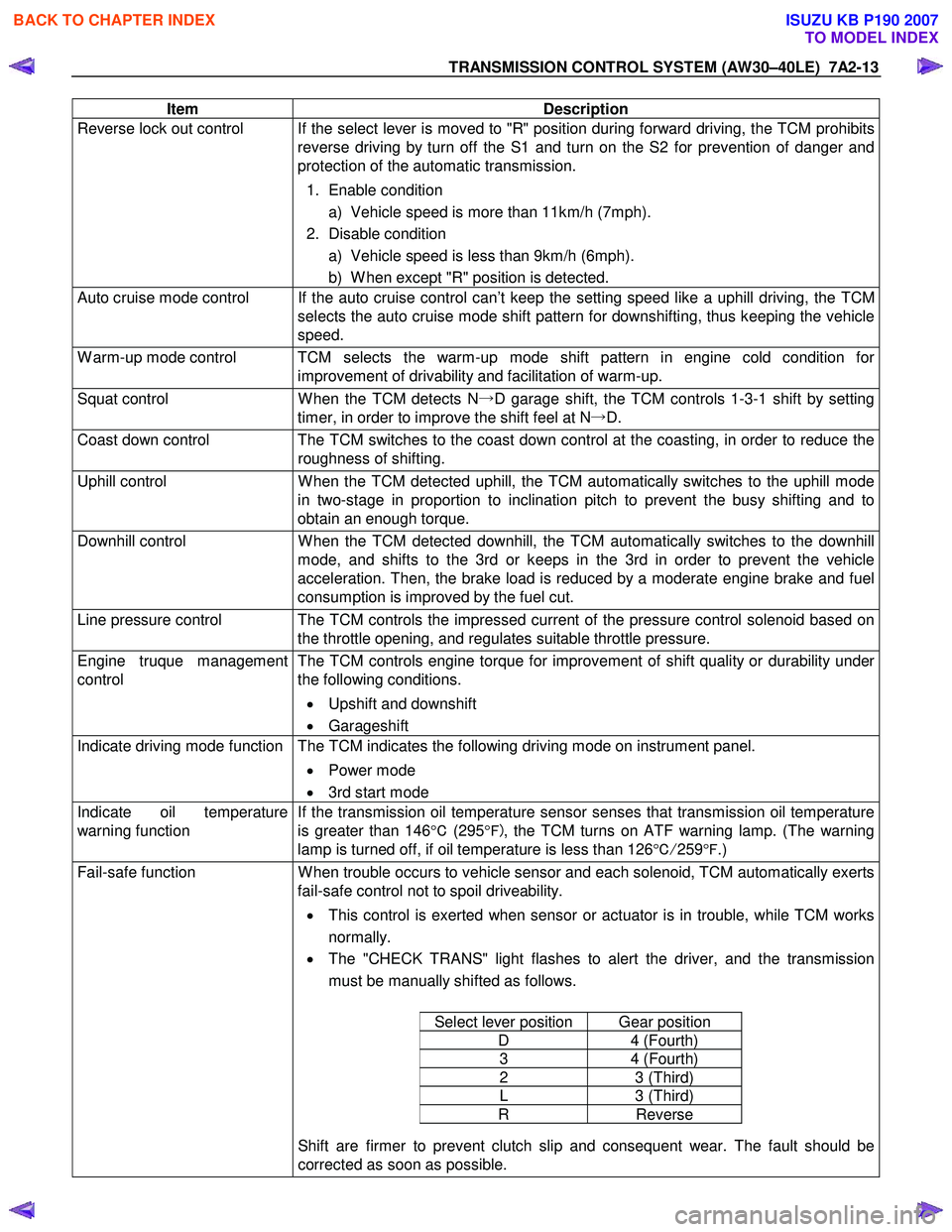
TRANSMISSION CONTROL SYSTEM (AW30–40LE) 7A2-13
Item Description
Reverse lock out control If the select lever is moved to "R" position during forward driving, the TCM prohibits
reverse driving by turn off the S1 and turn on the S2 for prevention of danger and
protection of the automatic transmission.
1. Enable condition a) Vehicle speed is more than 11km/h (7mph).
2. Disable condition a) Vehicle speed is less than 9km/h (6mph).
b) W hen except "R" position is detected.
Auto cruise mode control If the auto cruise control can’t keep the setting speed like a uphill driving, the TCM selects the auto cruise mode shift pattern for downshifting, thus keeping the vehicle
speed.
W arm-up mode control TCM selects the warm-up mode shift pattern in engine cold condition for improvement of drivability and facilitation of warm-up.
Squat control W hen the TCM detects N→D garage shift, the TCM controls 1-3-1 shift by setting
timer, in order to improve the shift feel at N →D.
Coast down control The TCM switches to the coast down control at the coasting, in order to reduce the
roughness of shifting.
Uphill control W hen the TCM detected uphill, the TCM automatically switches to the uphill mode
in two-stage in proportion to inclination pitch to prevent the busy shifting and to
obtain an enough torque.
Downhill control W hen the TCM detected downhill, the TCM automatically switches to the downhill
mode, and shifts to the 3rd or keeps in the 3rd in order to prevent the vehicle
acceleration. Then, the brake load is reduced by a moderate engine brake and fuel
consumption is improved by the fuel cut.
Line pressure control The TCM controls the impressed current of the pressure control solenoid based on the throttle opening, and regulates suitable throttle pressure.
Engine truque management
control The TCM controls engine torque for improvement of shift quality or durability under
the following conditions.
• Upshift and downshift
• Garageshift
Indicate driving mode function The TCM indicates the following driving mode on instrument panel.
• Power mode
• 3rd start mode
Indicate oil temperature
warning function If the transmission oil temperature sensor senses that transmission oil temperature
is greater than 146 °C (295 °F) , the TCM turns on ATF warning lamp. (The warning
lamp is turned off, if oil temperature is less than 126 °C/ 259 °F .)
Fail-safe function W hen trouble occurs to vehicle sensor and each solenoid, TCM automatically exerts
fail-safe control not to spoil driveability.
• This control is exerted when sensor or actuator is in trouble, while TCM works
normally.
• The "CHECK TRANS" light flashes to alert the driver, and the transmission
must be manually shifted as follows.
Select lever position Gear position
D 4 (Fourth)
3 4 (Fourth)
2 3 (Third)
L 3 (Third)
R Reverse
Shift are firmer to prevent clutch slip and consequent wear. The fault should be
corrected as soon as possible.
BACK TO CHAPTER INDEX
TO MODEL INDEX
ISUZU KB P190 2007
Page 3980 of 6020
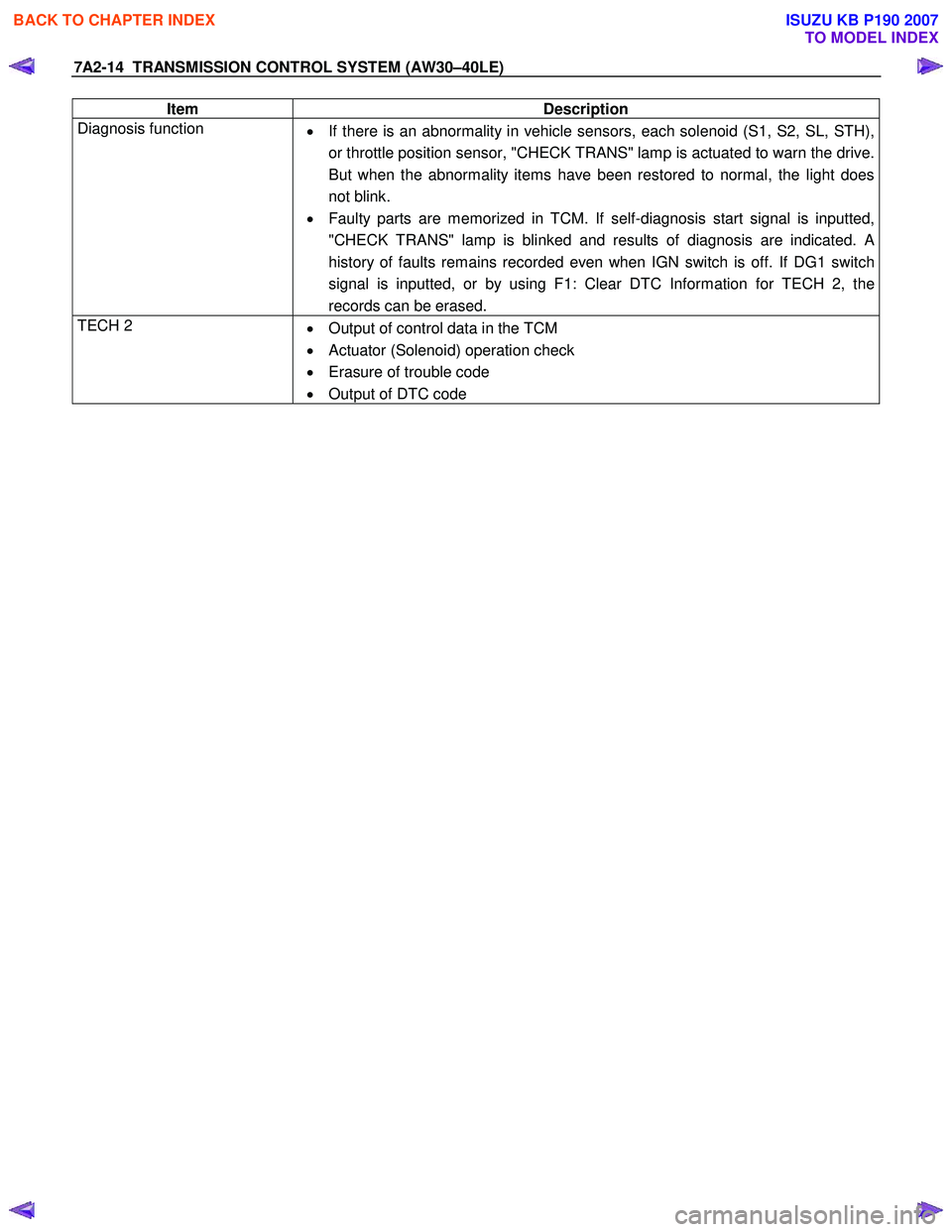
7A2-14 TRANSMISSION CONTROL SYSTEM (AW30–40LE)
Item Description
Diagnosis function
• If there is an abnormality in vehicle sensors, each solenoid (S1, S2, SL, STH),
or throttle position sensor, "CHECK TRANS" lamp is actuated to warn the drive.
But when the abnormality items have been restored to normal, the light does
not blink.
• Faulty parts are memorized in TCM. If self-diagnosis start signal is inputted,
"CHECK TRANS" lamp is blinked and results of diagnosis are indicated. A
history of faults remains recorded even when IGN switch is off. If DG1 switch
signal is inputted, or by using F1: Clear DTC Information for TECH 2, the
records can be erased.
TECH 2
• Output of control data in the TCM
• Actuator (Solenoid) operation check
• Erasure of trouble code
• Output of DTC code
BACK TO CHAPTER INDEX
TO MODEL INDEX
ISUZU KB P190 2007
Page 3988 of 6020

7A2-22 TRANSMISSION CONTROL SYSTEM (AW30–40LE)
Once the test vehicle has been identified an
“Application Menu” screen appears. Please select the
appropriate application.
The following table shows, which functions are used fo
r
the available equipment versions.
F0: Diagnostic Trouble Codes
F0: Read DTC Information
F1: Clear DTC Information
F1: Data Display
F2: Snapshot
F3: Actuator Test
F0: Solenoid 2-3 Test
F1: Solenoid 1-2/3-4 Test
F2: Pressure Control Solenoid (PCS)
F3: TCC Solenoid Test
F4: 3rd Start Lamp Test
F5: Power Lamp Test
F6: AT Oil Temperature Lamp Test
F7: Check Light Test
F4: Additional Functions
F0: Read ECU Identification
F5: Programming
F0: Program Vehicle Identification No.
BACK TO CHAPTER INDEX
TO MODEL INDEX
ISUZU KB P190 2007